|
Deerskin Coat
Text by Pamela Priest, Color Photos by Thomas Hunter
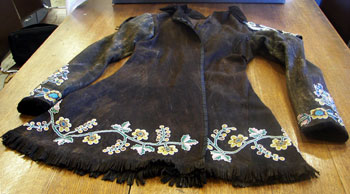
Beaded Deerskin Coat, Front
In April of 1815 Mt. Tambora, a stratovolcano in Indonesia, was the source of history's largest explosive volcanic eruption.1 The ash and other small particulate matter injected into the stratosphere reduced incoming solar radiation received at the earth's surface. Erupted sulfur compounds condensed into very tiny sulfuric acid droplets that formed clouds that stayed suspended in the stratosphere, further reducing incoming sunlight.2 Being a large eruption at a low latitude caused major global climate change by lowering temperatures world-wide. This led to the year of 1816 being called "the year without a summer" or "the cold year." For more details about what the weather was like during 1816, please see article below 'The Year Without a Summer Timeline.'
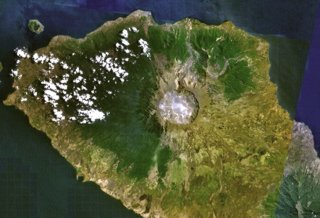
Mt. Tambora
from NASA Landsat7 image (worldwind.arc.nasa.gov)
As a result of "the year without a summer" in 1816, crops were injured and Indian corn, the primary food for Indian tribes, was destroyed. Chiefs from the Oneida nation were sent to Dr. Jonas C. Baldwin to request provisions for the winter. Dr. Baldwin provided for one-half, or 250 people, of the nation. These 250 Oneida Indians camped in woods in the vicinity of the village to be able to draw their daily rations.3 Dr. Baldwin gave them grain from his mill as well as other care. Dr. Baldwin was the father of Harvey Baldwin and a wealthy man who founded the village of Baldwinsville . As a result of his generosity, the Oneida Indians "adopted" his son Harvey with impressive ceremony into the tribe. Harvey was given this beautifully beaded ceremonial deerskin coat, and was also given the name of "Cohongoronto," which signifies a boat having a sharp prow constructed for the navigation of rapid waters, and intended as emblematical of the profession of law, which he was in the process of studying.4, 5, 6 Harvey Baldwin later became the first mayor of Syracuse .
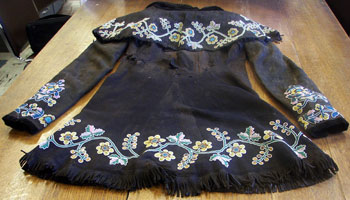
Beaded Deerskin Coat, back
This ceremonial deerskin coat was later presented to Crandall Melvin of the Onondaga Historical Association by John A. Morton, Jr., great-grandson of Harvey Baldwin, on November 11, 1949 , along with Harvey Baldwin's Bible.7
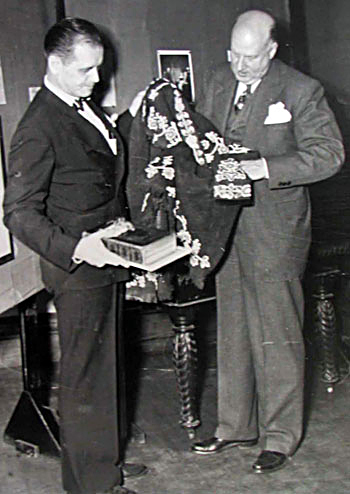
Crandall Melvin, right, accepting Ceremonial deerskin coat
from John A. Morton, Jr., great-grandson of Harvey Baldwin.
The Year Without a Summer timeline:8
The "cold summer of 1816," though not confined to Chautauqua county, is deemed worthy of record. The writer well remembers planting corn the 6th of June in a snow storm in the eastern part of the state, and can add his testimony to that of thousands still living, who have declared it to be the coldest season they have ever known. The following account of it was published in a Rochester paper about fifteen years ago. He thinks, however, that the reality was hardly equal to the description:
"Persons are in the habit of speaking of the summer of 1816, as the coldest ever known in America or Europe . Possessing some facts relative to this subject, we give them to revive the recollections of such among us as remember the year without a summer; and to furnish correct information for such as feel any interest in matters of this kind. We shall therefore give a summary of each of the months of the year 1816, extracted in part from 'Pierce on the Weather.'
"January was mild - so much so as to render fires almost needless in sitting-rooms. December preceding was very cold.
"February was not very cold. With the exception of a few days, it was mild, like its predecessor.
"March was cold and boisterous, the first half of it; the remainder was mild.
"April began warm, and grew colder as the month advanced, and ended with snow and ice, with a temperature more like winter than spring.
"May was more remarkable for frowns than smiles. Buds and fruits were frozen; ice formed half an ice in thickness, corn was killed; and the fields were again and again replanted, until deemed too late.
"June was the coldest ever known in this latitude. Frost and ice and snow were common. Almost every green herb was killed; fruit nearly all destroyed. Snow fell to the depth of ten inches in Vermont and in Maine ; three inches in the interior of New York . It fell also in Massachusetts .
"July was accompanied by frost and ice. On the morning after the 4th , ice formed of the thickness of a common window glass, throughout New England , New York , and some parts of Pennsylvania . Indian corn was nearly all killed; some favorably situated fields escaped. This was true of some of the hills of Massachusetts .
"August was more cheerless, if possible than the summer months already passed. Ice was formed half an inch in thickness. Indian corn was so frozen, that the greater part of it was cut down and dried for fodder. Almost every green thing was destroyed in this country and Europe . Papers from England said, 'It will ever be remembered by the present generation, that the year 1816 was a year in which there was no summer.' Very little corn in the New England and Middle states ripened; farmers supplied themselves from the corn produced in 1815 for seed in the spring of 1817. It sold for $4 to $5 a bushel.
"September finished about two weeks of the mildest weather of the season. Soon after the middle, it became very cold and frosty; ice forming a quarter of an inch in thickness.
"October produced more than its usual share of cold weather; frost and ice common.
"November was cold and blustering; snow fell so as to make sleighing.
"December was mild and comfortable.
"Very little vegetation matured in the Eastern and Middle states. The sun's rays seemed to be destitute of heat throughout the summer; all nature was clad in a sable hue; and men exhibited no little anxiety concerning the future of this life."
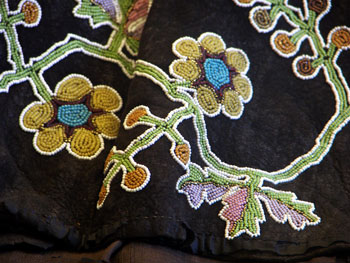
Detail of Beaded Deerskin Coat, bottom
Sources:
1. Tambora , Global Volcanism Program, Smithsonian National Museum of Natural History, http://www.volcano.si.edu/world/volcano.cfm?vnum=0604-04 Accessed July 22, 2006
2. The Little Ice Age in Europe: Possible Causes for Climate Change : Volcanic Eruptions , SUNY Suffolk, http://www2.sunysuffolk.edu/mandias/lia/possible_causes.html Accessed July 22, 2006
3. Onondaga; or Reminiscences of Earlier and Later Times , Vol. II, by Joshua V. H. Clark, A.M., Stoddard and Babcock, Syracuse, 1849, pg. 170.
4. Early Landmarks of Syracuse , N.Y. , by Gurney S. Strong, The Times Publishing Company, 1894, pg. 21
5. Early Onondaga in Letters to Young Students , edited by Mary Josephine Hasbrouck, Bardeen's Inc., Syracuse , NY., 1942, pg. 25
6. First Mayor's Kin Delighted to Bring Historic Coat Here , The Post-Standard, Friday, November 11, 1949 , pg. 25
7. ibid
8. History of Chautauqua County , New York , by Andrew W. Young, Printing House of Matthews & Warren, Buffalo , NY , 1875, pp. 623-4.
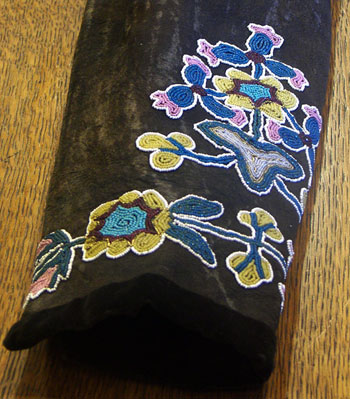
Detail of beaded deerskin coat, left sleeve
September 2007
Model of the First Pompey Academy
In the early 1800's Pompey consisted mainly of log cabins and a few framed houses. There were no real roads and no large cities nearby. As of 1800, Pompey had only been a settlement for eight years. With a population of three hundred and nine people, nearly one third of Onondaga County's population as a whole, the town of Pompey wanted to "out grow" their log city. Pompey's citizens decided that an academy, to educate their children was the place to start this change. In January, 1800, a select few members of the Pompey community took a petition they had signed along with $1,300 to Albany to meet with the Board of Regents in the Senate Chamber. At the time $1,300 was a great deal of money as the country was near bankruptcy due to Revolutionary War expenses. The Regents Board approved the Academy, but declared that the town of Pompey must first erect and furnish a suitable building. The people of Pompey were still dedicated to the idea of an Academy and were committed to completing their goal. They sacrificed both time and money to the Academy, their children, and ultimately the future of their town.
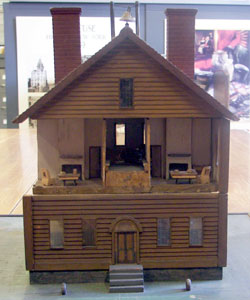
First Pompey Academy Model, front view
A board of trustees was appointed and in 1803 the people broke ground on a lot located on Henneberry Road on the north corner of Academy Street . At the time the lot was owned by Jessie Butler, but was later deeded to the Academy in 1811 as part of his contribution and donation to the Academy. William Lathrop was the carpenter for the two storied, framed building, measuring forty by fifty feet which would soon house Pompey's Academy. In 1810 the Academy was finished, painted yellow and furnished. The following year the school was opened and students from all over Onondaga County attended the Academy. The first teacher, Ely Burchard, taught at the academy from 1811-1813 earning a salary of $350 a year.
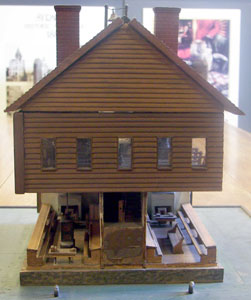
First Pompey Academy Model, rear view
In 1834, ground was broken for a new Pompey Academy and the original Academy was closed for good. In 1957, the Academy was torn down altogether and replaced by the Pompey Elementary School , which was later converted into the Pompey Fire Department. Today a blue sign marks the spot in Pompey where the original Academy once stood.
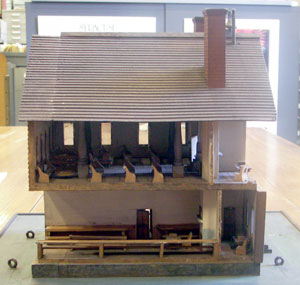 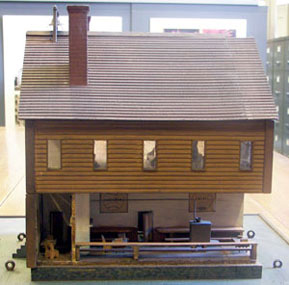
First Pompey Academy Model, left side (left) and right side (right)
The model of the original Pompey Academy was made by William H. Stevens in the years 1871-1874, constructed from his memories of what the Academy had once looked like.
First Pompey Academy Model, inside detailed views
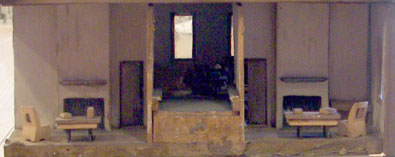
First Pompey Academy Model, front view
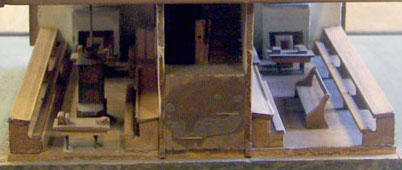
First Pompey Academy Model, rear view
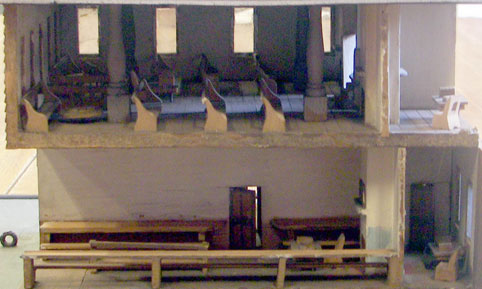
First Pompey Academy Model, left side view
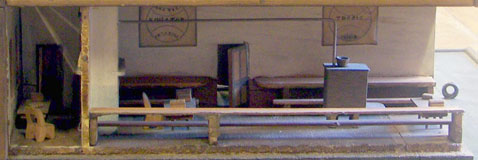
First Pompey Academy Model, right side view
July 2007
General Electric Television Set Production in Syracuse, NY, 1948-1980

This General Electric televisions set, c. 1965, was made at Electronics Park, Syracuse, NY.
It is a gift from Manley and Marion Sherman, Syracuse, NY.
On October 15, 1878, Thomas Alva Edison and his investors formed a company for the purpose of inventing an electric lamp. Years later, after many mergers, the remains of that company resided in a small plant on Wolf Street , in our very own Syracuse , New York . With the start of World War II and the need for mass production of war-time necessities, this little company, known as General Electric, began to grow. In 1942, it became apparent that the plant needed to expand, and additional plants were created on Thompson road. In 1943, the first shipments left the newly expanded plant. By the end of that year, war production had increased and the plant's shipments now required two hundred freight cars each month. With General Electric's great contributions to wartime productions, the secretary of the navy, Frank Knox, paid the company a visit. It was at this time he made a speech in which he praised the company's hard work. "No single industry in America has made a better response, a quicker response to our appeal for help than General Electric. I don't think what you've done here can be duplicated anywhere in the world.. You are making the things which are absolutely essential to victory in this war. So lift up your heads with pride, the same kind of pride that men who wear the uniforms of this country have when they go forth to battle for us. Because in the highest possible sense you are battling for everything for which America stands."
After expanding to twenty two plants, it was decided there was a need for a headquarters plant. More than one hundred communities were considered as possible sites for the headquarters. Based on factors of availability of labor, air, railroad and highway transportation, hotels, and the proximity of raw materials and markets, Syracuse was selected to be the home of the new Electronics Park . Construction began in 1945 and by 1948, the park, located outside of Liverpool , was in business. The cost to construct the park was approximately ten million dollars. It was expected to bring millions of dollars a year to Syracuse and create thousands of new jobs. The park was originally built to hold 6,500 employees, but was expected to only have 4,000- 4,500 employees. During the World War II era the park employed the expected number of 4,500 people. But by the 1960's the original expectations were greatly exceeded. In 1966, the company employed 18,750 people. The company had grown tremendously, and although by 1969, it only employed 13,500 people, the number of employees was more than double the original intended amount.
Over the years, General Electric's engineers worked hard to create new advances in technology. In 1944, the new miracle timing tube was invented, a device which takes pictures in a millionth of a second, photographing the invisible, such as heat-waves. This device was intended for military use and could possibly be used to detect and solve problems of airplane design. In 1954, the atomic submarine, Nautilus, which was commissioned to explore under artic ice caps, had a General Electric television from the plant in Syracuse and equipment so sensitive it could "see in the dark" by use of sonar. In the 1960's new ways to identify fingerprints by computer were invented. At the time it was believed that fingerprints and this new computer program would serve as the credit cards of the future. Being forty years in the future, we know that this notion is not yet true. However, this program did and does help law enforcement agencies search electronically for fingerprints in their databases. In 1974, a tiny sensor was developed, making it possible for tiny TV cameras to monitor front doors. In 1983, a microscope using sound-waves was invented to detect flaws in production parts. Also in 1983, a sonar system, named TACTAS or Tactical Towed Array Sonar, was invented and expected to aid in sub warfare. The system uses sonar to interpret sounds under water, making them easy to locate and identify.
General Electric made television sets from 1947-1985. In Syracuse , televisions were made in Building Five ( Receiver Building ) at Electronics Park beginning in 1948. That year about 2,300 employees made four different sets: two table models and two consoles. The first models featured ten and twelve inch screens, a far cry from panoramic 65" projection sets available today! Because of the delicate nature of assembling televisions in 1948, GE utilized nimble-fingered women to assemble the components.
GE manufactured its first color television set in 1956. However, by the beginning of 1957 color set sales had already slumped due to consumers reluctance to spend more money on this recent development. GE stopped producing color televisions until 1966.
 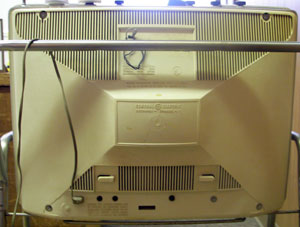
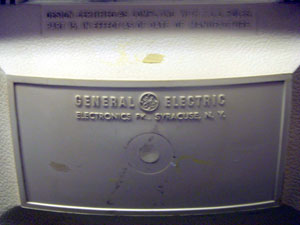
In 1965, GE introduced a portable monochrome set with a 16" screen similar to OHA's television set, the one pictured here. Production of monochrome (black & white) sets remained strong throughout the 1960s. However, renewed interest in color sets caused sales of monochrome sets to drop.
In 1970, GE discontinued the black & white tubes in favor of the color tube. In 1971, a section of General Electric, General Electric Supply Co. moved to a new building in East Syracuse . In 1977, GE announced it was embarking on a joint production venture with the Japanese firm Hitachi . In 1980, GE stopped producing television sets in Syracuse and moved its production to Portsmouth , VA. In 1985, GE stopped making color sets in Virginia as well.
In 1992, GE sold its Syracuse factories to Martin Marietta Corp. for $3.05 billion dollars.
In 1995, the company Martin Marietta Corp. merged with the Lockheed Corp. creating the company which resides in Syracuse today, Lockheed Martin.
General Electric Electronics Park Pamphlet

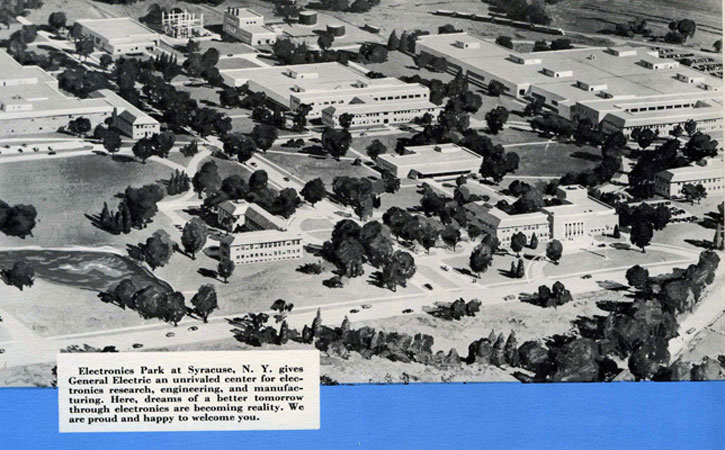
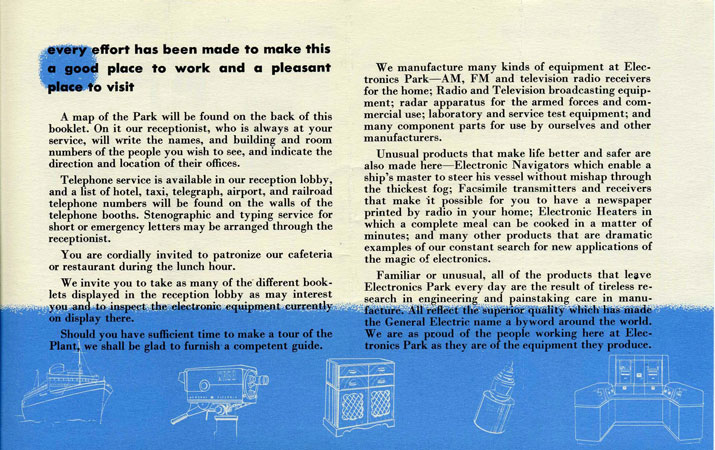
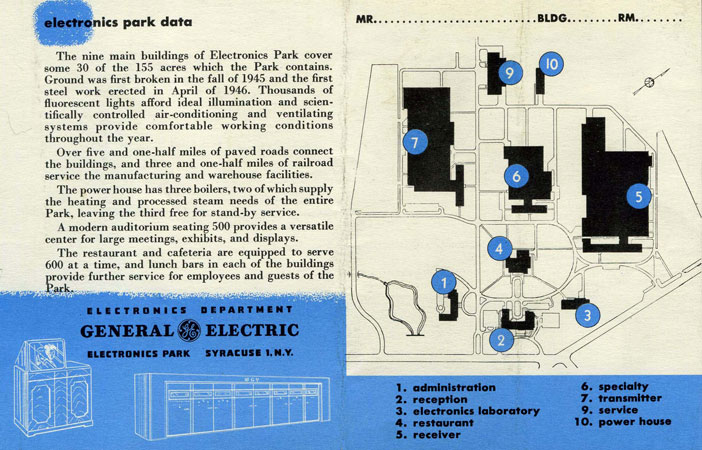
July 2006
The First Ovariotomy
Oil on Canvas Painting
George Kasson Knapp, 1877-78
68.5" W x 51" H
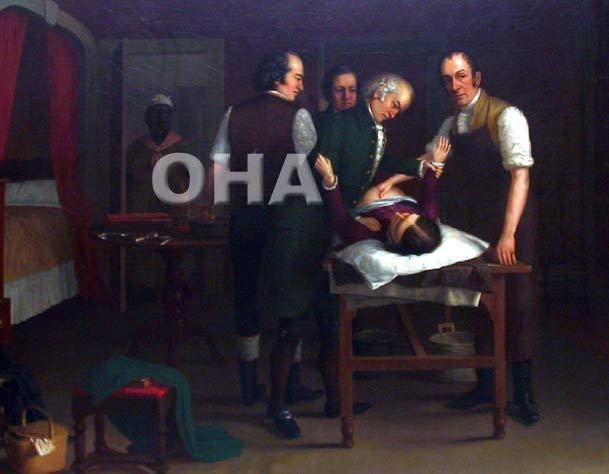
The First Ovariotomy is a framed painting by the artist George Kasson Knapp. The scene is set in Danville, Kentucky on Christmas Day in 1809. Depicted in this painting is Dr. Ephraim McDowell (1771-1830), as he begins an operation to remove a twenty-two pound ovarian tumor from the abdomen of Mrs. Jane Todd Crawford (1763-1842). Dr. McDowell has made the incision and is probing Mrs. Crawford’s abdomen for the tumor. With his attention concentrated at the ends of his fingers, Dr. McDowell has a far off look. Upon the table, foreshortened, with her head to the observer, lies Mrs. Crawford. Conducted several years before the common use of anesthesia, Mrs. Crawford is enduring the severe pain of this surgery. Prone as she is upon the table, yet in the upturned face, in the extended arms, in the strained grasp of the hands is depicted suppressed, intense, mental emotion. She has struggled, as is suggested by the gray-haired man who has gently pressed her back upon the pillow, holding also her extended right forearm. Opposite stands, Dr. James McDowell, Ephraim’s assistant, who is handling the instruments and sponges. At the foot of the operating table stands a medical student observing the procedure. An African-American servant or slave is entering the room carrying a vessel of water. Dr. McDowell successfully completed this dangerous operation in twenty-five minutes, and it marked the first time that this medical procedure had been effectively accomplished, affording Mrs. Crawford a full thirty-three years to live thereafter.
Despite his lack of knowledge regarding anesthetics and the need for practicing sterile methods, Dr. Ephraim McDowell was a pioneer in the beginning of abdominal surgery in the United States. Dr. McDowell has received prominence through a commemorative stamp and television program. Dr. McDowell is also the great, great grandfather of Mary McDowell Reynolds, wife of James A. Reynolds, a former member of the board of directors of the Onondaga Historical Association Museum & Research Center. Mrs. George Palmer, the artist’s daughter, gave the painting to OHA about 1920.
George Kasson Knapp was one of the earliest local painters from Syracuse, N.Y. He began painting in Syracuse about 1832, later moving to New York City where he would become a known artist. Mr. Knapp followed the old school of painting, avowing himself a realistic painter. Along with Mr. Sanford Thayer, Mr. Knapp was invited by George Fisk Comfort to assist in founding the College of Fine Arts at Syracuse University. Mr. Knapp served as honorary professor at the college and eventually started the Knapp Art Gallery there.
In 1877 Mr. Knapp conceived the idea of becoming an historical painter, and began to depict The First Ovariotomy Mr. Knapp carefully researched the history of the case and was able to execute an accurate representation of the landmark operation. Upon its completion in the spring, 1878, the painting was exhibited at the convention of the National Association of Physicians at Buffalo, NY, eliciting praise from both doctors and artists.
April/May 2006
Frederick Douglass Daguerreotype and Autograph
Text by Pamela Priest
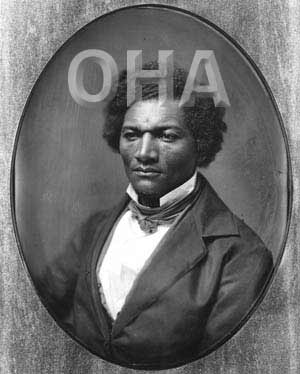
Earliest known photograph of Frederick Douglass at about 26 years of age, c. 1841-45. This photograph of Frederick Douglass was taken when he was about 26 years old, c. 1841-1845. It was probably taken before Douglass' anti-slavery trip to England. The original photograph is a full-plate daguerreotype, which is unusual, as most daguerreotypes are developed on either half or quarter plates. This daguerreotype is in the OHAM&RC collection.
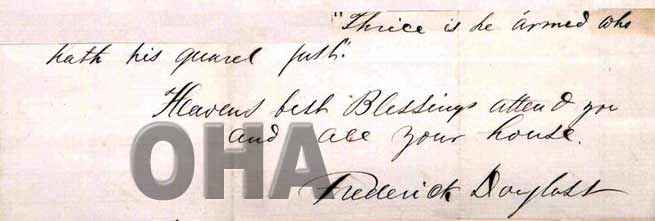
Autograph of Frederick Douglass. Transcription of Frederick Douglass' autograph
"Thrice is he armed who hath his quarel just"
Heavens best Blessings attend you and all your house.
Frederick Douglass
Interpretation of autograph quote:
From William Shakespeare's King Henry the Sixth, part 2, act 3, scene 2
"What stronger breastplate than a heart untainted!
Thrice is he armed that has his quarrel just,
And he but naked, though locked up in steel,
Whose conscience with injustice is corrupted"
Frederick Douglass appeared in Syracuse on several occasions. Not only did he come to Syracuse to deliver various lectures, but he also came here to recruit volunteers for a new Union Army regiment of African Americans forming in Boston. Frederick Douglass, who came to Syracuse March 11, 1863 to recruit for the Massachusetts 54th Regiment, was quoted as saying "The arm of the slaves is the best defense against the arm of the slave holder." The Massachusetts 54th Regiment was told in the 1989 movie "Glory."
Other Syracuse appearances: 1843 in Fayette Park, under a small tree, with five women and men listening to his words. By the end of the afternoon, he had 500 people listening to him.
On Tuesday evening, August 20, 1850, Frederick Douglass lectured on the subject of Slavery at City Hall. He was on his way to the great Convention of Fugitive Slaves and their abettors held at Cazenovia the following evening.
On February 8, 1856, Frederick Douglass delivered his speech on "The Unity of the Human Race" at City Hall. The entrance fee of a shilling went towards the expenses of the Underground Railroad.
On Thursday evening, Nov 14, 1861 Mr. Douglass gave a speech entitled "The Rebellion - It's Cause and Remedy" in front of 800 people in the Wieting Hall. He urged the immediate emancipation of the slaves, and their use as soldiers, as the quickest, most economical and humane way of terminating the Civil War. He delivered his speech with complete silence from his audience. In the many cities and towns of the north that he had delivered this speech to, he was never interrupted or disturbed. Given the storm of controversy leading up to his visit, the Mayor of Syracuse provided 100 policemen to attend the lecture, along with the Second Onondaga Regiment, whose 45 representatives were armed with muskets.
On Friday evening, Nov 15, 1861, he spoke on the subject of "Life Pictures." It was a lecture of a literary character, and had no reference to political affairs.
On March 27, 1863, the Syracuse Journal reported: "The war meeting at Zion's Church last evening was largely attended. Frederick Douglass made an effective address and six recruits responded. There have been 23 colored recruits raised in this city and they will be sent forward next week."
On May 3, 1864, Frederick Douglass lectured at Shakespeare Hall.
On Tuesday evening, Dec 15, 1868 Frederick Douglass lectured at Wieting Hall on "William the Silent."
On Tuesday evening, October 26, 1869 he lectured before the Zion's Church Aid Society, at Shakespeare Hall On Saturday evening, Dec 21, 1872 Frederick Douglass delivered his new lecture at the Wieting Opera House.
On the Tuesday evening June 15, 1874 he delivered his third lecture in the Independent Church course. His subject was "John Brown," the hero and martyr.
On Oct 31, 1879, the Syracuse Journal reported on the speech delivered by Frederick Douglass in Utica: "The Hon. Frederick Douglass said he had appeared before the American people, during the last forty years, as a slave, a fugitive slave, a man, and a man among men, and at last through the courage of the Republican party, he was able to appear as an American citizen, under the flag at last."
|